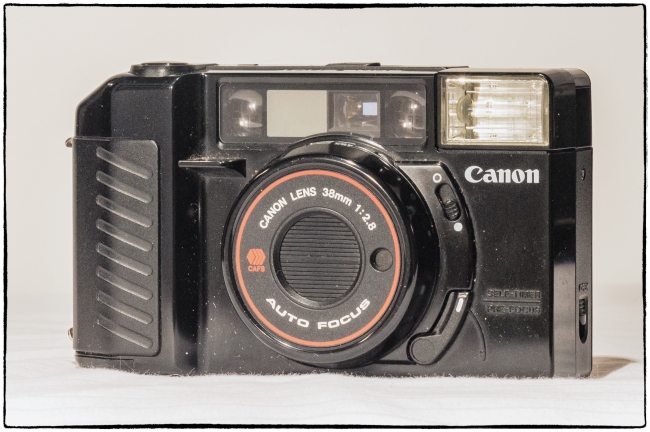I came across this camera in a nearby thrift store (Goodwill). It seemed to be in pretty good shape and had a solid feel to it. Although I’d already read about this camera before I’d forgotten about it. So I left it. After returning home I looked it up and discovered that it might have some historical significance. The Konica C35 AF (which I also have) was the first autofocus camera, but it apparently had a not particularly impressive passive autofocus system. The Canon AF35M introduced a better active autofocus system, which I believe has formed the basis for camera autofocus ever since.
According to a post (Canon AF 35M), which also provides a detailed review of the camera on Mike Eckman’s excellent site:
In terms of historical significance, the AF35M was the first camera in the world to offer a modern automatic focusing system. The reason I threw the word “modern” in that previous sentence is because its actually the second auto-focus camera released in the late 70s. The first was the Konica C35 AF which came out two years earlier in November 1977. Many people do not consider the Konica C35 AF to be a truly automatic focus camera because Konica “cheated” somewhat in how they accomplished automatic focus.
An ad from 1980 for the AF35M hyped the frustration free simplicity of the camera. Konica employed the use of the Visitronic AF system that was created and produced by Honeywell. This system was a passive auto-focus design which used a traditional two window rangefinder to compare the light entering each window, and through the use of a primitive CPU, it would estimate range and then adjust the focus of the lens to achieve proper focus. Canon’s CAFS (Canon Auto Focus System) from the AF35M used a scanning infra-red light beam that would triangulate distance by reflected light bouncing back to the camera. Konica’s system was easily tricked and could not handle moving or very small objects very well. Canon’s CAFS system was far from fool-proof, but it handled a variety of scenes, including low light situations, much more reliably.
I also discovered that the camera is capable of taking impressive pictures (see A Canon in A Minor – the AF35M on Random Camera Blog).
I had to go back to the same area the following day and I decided that, if the camera was still there, and if the price was less than $10 I’d get it (the camera had no price sticker on it). As it turned out the price was $5 so I got it.
Surprisingly the camera had functioning batteries in it and fired up immediately when I turned it on. Everything else seemed to be working fine too.
I did a bit more research and discovered that this particular model was not the first in the series though. There are a large number of different models from the first in 1979 to the last in 2005. I’m most interested in the early models. The first three models were (the names represent the way the camera was designated in the USA, Europe and Japan):
Canon Sure Shot/AF35M/Autoboy (1979)
Canon Super Sure Shot/AF35ML/Autoboy Super (1981)
Canon (New) Sure Shot/AF35M II/Autoboy 2 (1983)
The one I had was the third: (New) Sure Shot, AF35 M II, Autoboy 2. The problem arises because the first and third US models are both labeled on the top plate as simply ‘Sure Shot’. Of course I decided that I had to have the first. I found one on ebay and hope to receive it soon. Then I’ll have decide if I want the Super Sure Shot with its faster lens (f1.9 instead of f2.8). A quick look at ebay tells me that this model is somewhat more expensive so maybe I’ll just wait and see if I bump into one in a thrift store of flea market.

